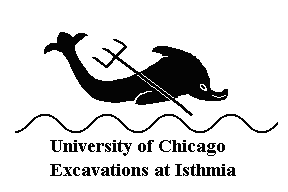UNIVERSITY OF CHICAGO EXCAVATIONS AT ISTHMIA, 2010
PUBLICATIONS
A volume of seventeen essays entitled “’The Bridge of the untiring sea’: The Isthmus of Corinth from the Bronze Age to Late Antiquity” edited by E. R. Gebhard and T. E. Gregory has been submitted to the American School of Classical Studies in Athens for publication as a volume in the Isthmia series or as a Hesperia supplement. Included in the collection is the editio princeps of an Isthmian victor list found in Corinth and the publication of five marble statues from the Roman shrine of Palaimon. While addressing a variety of topics, all papers explore the links between the city of Corinth, the Sanctuary of Isthmian Poseidon, and the area of the Isthmus.
Proceedings of a conference on the Archaeology of the Korinthia held at Loutraki (26-29 March 2009) are in publication by the German Archaeological Institute in Athens. The volume includes a paper by Alastar Jackson on the battle at Leukopetra of 146 B.C. which led to the sack of Corinth and the Isthmian Sanctuary, and one by Elizabeth Gebhard on Pausanias at the Isthmus.
Study was completed for publication of four stelai, probably belonging to 224 and 220 B.C., recording interstate treaties between Macedon and various Greek cities A joint paper by Klaus Hallof, Berlin-Akadamie der Wissenschaften, Peter Funke, Műnster University, and Elizabeth Gebhard is planned. The stelai stood along the Corinth-Isthmus road, immediately north of the Temple of Poseidon and were very likely destroyed at the time of an unsuccessful siege against Corinth in 198 B.C.
STONE SAMPLING
Christopher Hayward, Edinburgh University, as a part of his research on Corinthian quarries, photographed and studies blocks from the Archaic and Classical Temples of Poseidon. Hayward suggested that the grey limestone used in two of the Hellenistic stelai mentioned above came from the area of Corinth-Acrocorinth.
EPIGRAPHY
Matthew Trundle, Victoria University of Wellington, New Zealand, has undertaken to complete the late Daniel Geagan’s manuscript on Roman-period inscriptions from the Isthmian Sanctuary. He plans to present the material in two articles for Hesperia following Geagan’s original division of the stones: commemorative stelai, victor stelai, plaques and statue bases.
Publication of the Greek inscriptions studied by the late Michael Jameson is being continued by Klaus Hallof, as noted above.
LATE ARCHAIC AND CLASSICAL POTTERY Martha Risser, Trinity College.
Martha Risser has identified unusually large stewpots and covered serving platters as vessels very likely used for the sacrificial feast at the Isthmian Games during the late 6th and 5th century B.C. Those used for individual servings are slightly smaller; kotylai, skyphoi, and one-handled cups may have fulfilled a dual function both as bowls for food and cups for wine.
Distribution of the pottery suggests that some meat was roasted at the altar and the remainder was boiled. Feasting itself took place near the great circular reservoir that supplied water to the Archaic sanctuary.
ARMS AND ARMOR Alastar Jackson, Manchester University
Spear and javelin fragments were drawn and grouped for publication. Jackson studied comparanda at Nemea Museum. Final text was supplied for arms from the Rachi Settlement that are included in Virginia Anderson-Stojanovic’s volume. Jackson again explored the archaeological remains the ridge south of the sanctuary and as far as the radio tower in the light of P. Monceaux’s report that describes a much more extensive settlement than the one that has been uncovered (Gazette Archéologique 10, 1885 pp.402-404).
MUSEUM and SITE
In the climatized room for photographs and metal objects.
new dexion shelving for the photographic archives and objects requiring a special atmosphere were installed together with a fitted cabinet for slides. In the apotheke Angeliki Kandri, and Nicholaos Rothonis continued removing context pottery to plastic containers and reorganizing and conserving inventoried objects. The hero shrine known as the West Foundation was cleaned and fenced in response to a request from the ΛΖ’ Ephoreia.
Elizabeth Gebhard
Director, University of Chicago Excavations at Isthmia
25 October 2010

